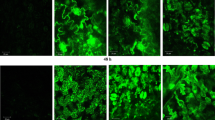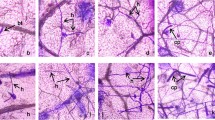Abstract
Alterations in some physiological processes in source leaves of sugar beet—such as chlorophyll and carbohydrate concentrations, stomatal conductance, rate of net photosynthesis and transpiration, and activity of the photosynthetic apparatus during root interaction with Aphanomyces cochlioides, were investigated. The influence of time of infection on plant health, yield quality and quantity was also examined. Plants were infected at different times of their growth period: on the sowing day and 4 or 8 weeks after sowing. A variation treatment, with non-pelleted seeds infected on the sowing day, was also analyzed. The experiment showed that development of disease symptoms depends on the time of infection and seed protection. A significant root yield decrease was observed in case of late infection, as compared to the yield of plants infected on the sowing day. The fresh weight of leaves was significantly increased where there was late infection. The infected plants showed a lower content of K+, Na+ and α-amino-N than did the controls. Infection by A. cochlioides induced chlorophyll degradation mostly in older leaves with the occurrence of natural senescence processes. Chlorophyll fluorescence parameters indicated that the photosynthetic apparatus of younger leaves was more sensitive to pathogen infection, when compared to older ones. The photochemical efficiency of photosystem II was reduced in young leaves mainly due to disturbance of the water-splitting system. In plants grown from non-pelleted seeds a strong impairment of PSII was observed only in those leaves which developed during early pathogen infection. In young leaves of plants infected in the fourth week after sowing, inhibition of the rate of net photosynthesis was correlated with the increase in intercellular CO2 concentration, indicating some disturbance in the carbon assimilation phase. In mature leaves of late infected plants the reduction of photosynthesis net rate was associated with a decrease of stomatal conductance and an increase of diffusion resistance to CO2 and H2O, which was also the cause of the transpiration rate inhibition. When the leaves developed during early infection, an increase of specific leaf weight and accumulation of carbohydrates was observed. In mature leaves of non-protected plants infected on the sowing day, the recovery of all physiological processes was observed together with a diminution of disease symptoms.











Similar content being viewed by others
References
Baker, N., & Rosenqvist, R. (2004). Application chlorophyll fluorescence can improve crop productivity strategies: an examination of future possibilities. Journal of Experimental Botany, 55, 1607–1621.
Bassanezi, R. B., Amorim, L., Bergamin, F. A., & Berger, R. D. (2002). Gas exchange and emission of chlorophyll fluorescence during the monocycle of rust, angular leaf spot and anthracnose on bean leaves as a function of their trophic characteristics. Journal of Phytopathology, 150, 37–47.
Bolwell, G. P. (1999). Role of active oxygen species and NO in plant defence responses. Current Opinion Plant Biology, 2, 287–294.
Burgieł, J.Z. (1980). Wpływ niektórych herbicydów na występowanie i rozwój patogenów powodujących choroby podsuszkowe pszenicy ozimej. Cz.I. Występowanie chorób podsuszkowych (in Polish). Acta Agr. et Silv., Seria Agraria, XIX, 3–13.
Duffus, J. E., & Ruppel, E. G. (1993). Diseases. In D. A. Cooke & R. K. Scott (Eds.), The Sugar Beet Crop (pp. 346–427). London: Chapman and Hall.
Hall, G. (1989). Aphanomyces cochlioides. CMI Descriptions of pathogenic fungi and bacteria, No. 972. Mycophatology, 106, 185–186.
Harveson, R.M., & Carlson, C.C. (2003). Response of sugar beet cultivars to Aphanomyces and Rhizoctonia root rots under optimal conditions in the greenhouse. In: Proceedings of 1st joint IIRB-ASSBT Congress, 26th Feb.-1st March 2003, 865–869, San Antonio, USA
Heijbroek, W., & Huijbregts, A. W. M. (1995). Fungicides and insecticides applied to pelleted sugar-beet seeds—II. Control of pathogenic fungi in soil. Crop Protection, 14(5), 363–366.
Herbers, K., Takahata, Y., Melzer, M., Mock, H. P., Hajirezaei, M., & Sonnewald, U. (2000). Regulation of carbohydrate partitioning during the interaction of potato virus Y with tobacco. Molecular Plant Pathology, 1, 51–59.
Horio, T., Kawabata, Y., Takaymata, T., Tahara, S., Kawabata, J., Fukushi, Y., et al. (1992). A potent attractant of zoospores of Aphanomyces cochlioides isolated from its host, Spinacia oleracea. Experientia, 48, 410–414.
Howe, G. A. (2001). Cyclopentenone signals for plant defence: Remodelling the jasmonic acid response. PNAS, 98, 12317–12319.
Islam, M. T., Ito, T., & Tahara, S. (2001). Morphological studies on the Aphanomyces cochlioides zoospore and its changes during the interaction with host materials. Journal of General Plant Pathology, 67, 255–261.
Islam, M. T., Ito, T., & Tahara, S. (2003). Host-specific plant signal and G-protein activator, mastoparan, trigger differentiation of zoospores of the phytopathogenic oomycete Aphanomyces cochlioides. Plant and Soil, 255, 131–142.
Krause, G. H., & Weis, E. (1984). Review: Chlorophyll fluorescence as a tool in plant physiology. II. Interpretation of fluorescence signals. Photosynthetic Research, 5, 139–157.
Krause, G. H., & Weis, E. (1991). Chlorophyll fluorescence and photosynthesis: the basics. Annual Review of Plant Physiology Plant Molecular Biology, 42, 313–349.
Luterbacher, M. C., Asher, M. J. C., Beyer, W., Mandolino, G., Scholten, O. E., Frese, L., et al. (2005). Source of resistance to diseases of sugar beet in related Beta germplasm: II. Soil-borne diseases. Euphytica, 141, 49–63.
Neill, S., Desikan, R., & Hancock, J. (2002). Hydrogen peroxide signaling. Current Opinion Plant Biology, 5, 388–395.
Noguės, S., Cotxarrera, L., Alegre, L., & Trillas, M. I. (2002). Limitations to photosynthesis in tomato leaves induced by Fusarium wilt. The New Phytologist, 154, 461–470.
Papavizas, G. C., & Ayers, W. A. (1974). Aphanomyces species and their root diseases in pea and sugar beet—A review. USDA Technical Bulletin 1845. Washington, DC.
Payne, P. A., & Williams, G. E. (1990). Hymexazole treatment of sugar-beet seed to control seedling disease caused by Pythium spp. and Aphanomyces cochlioides. Crop Protection, 9, 371–377.
Payne, P. A., Asher, M. J. C., & Kershaw, C. D. (1994). The incidence of Pythium spp. and Aphanomyces cochlioides associated with the sugar-beet growing soils of Britain. Plant Pathology, 43, 300–308.
Pieterse, C. M. J., van Wees, S. C. M., van Pelt, J. A., Knoester, M., Laan, R., Gerrits, H., et al. (1998). A novel signaling pathway controlling induced systematic resistance in Arabidopsis. The Plant Cell, 10, 1571–1580.
Rubin, B., & Arcichowska, J. (1971). Biochemia i fizjologia odporności roślin (in Polish). Warszawa: PWRiL.
Scharte, J., Schön, H., & Weis, E. (2005). Photosynthesis and carbohydrate metabolism in tobacco leaves during an incompatible interaction with Phytophthora nicotianae. Plant, Cell & Environment, 28, 1421–1435.
Scheideler, M., Schlaich, N. L., Fellenberg, K., Beissbarth, T., Hauser, N. C., Vingron, M., et al. (2002). Monitoring the switch from housekeeping to pathogen defence metabolism in Arabidopsis thaliana using cDNA arrays. Journal of Biological Chemistry, 277, 10555–10561.
Šikalčik, N. V., & Botjan, G. N. (2002). Integrated sugar beet protection against diseases (in Polish with English summary). Progress in Plant Protection, 42(1), 102–109.
Thomma, B. P. H. J., Eggermont, K., Penninckx, I. A. M. A., Mauch-Mani, B., Vogelsaang, R., Cammue, B. P. A., et al. (1998). Separate jasmonate-dependent and salicylate-dependent defence-response pathways in Arabidopsis are essential for resistance to distinct microbial pathogens. PNAS, 95, 15107–15111.
Waffenschmidt, S., & Jaenicke, L. (1987). Assay of reducing sugars in the nanomole range with 2-2′ bicinchoninate. Analitical Biochemistry, 165, 337–340.
Walker, R. (2002). Development of bacterial seed treatments for the control of Aphanomyces cochlioides on sugar beet. Ph.D Thesis. UK: University of Nottingham.
Williams, G. E., & Asher, M. J. C. (1996). Selection of rhizobacteria for the control of Pythium ultimum and Aphanomyces cochlioides on sugar-beet seedlings. Crop Protection, 15, 479–486.
Windels, C. E. (2000). Aphanomyces Root Rot on Sugar Beet, Online. Plant Health Progress:10.1094/PHP-2000-0720-01-DG
Acknowledgements
The research was financially supported by KWS Polska and Südzucker Polska.
Author information
Authors and Affiliations
Corresponding author
Rights and permissions
About this article
Cite this article
Chołuj, D., Moliszewska, E.B. The influence of Aphanomyces cochlioides on selected physiological processes in sugar beet leaves and yield parameters. Eur J Plant Pathol 132, 59–70 (2012). https://doi.org/10.1007/s10658-011-9848-5
Accepted:
Published:
Issue Date:
DOI: https://doi.org/10.1007/s10658-011-9848-5




